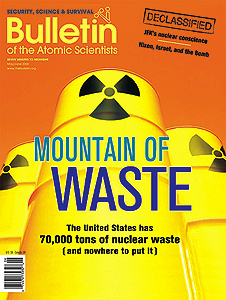Bulletin of the Atomic Scientists ‘remains steadfast in its clarion call,’ wins national general excellence award
By Steve KoppesNews Office
   Honored in the category of publications with a circulation under 100,000 and leading a field of five finalists that included I.D., Metropolis, Print and the Virginia Quarterly Review, the Bulletin of the Atomic Scientists won the 2007 National Magazine Award for General Excellence. The issues above are the three entries that won the award. | |
The first issue of the Bulletin of the Atomic Scientists appeared in December 1945, as a modest, six-page newsletter. The product of Manhattan Project scientists at Chicago, the Bulletin was devoted exclusively to their concerns about the release of nuclear energy. Contemporary readers know it as a glossy watchdog publication that encompasses a broader scope, informing the world about weapons of mass destruction, international security issues, the arms trade and the nuclear industry.
In recognition of that history and the continuing importance of nuclear energy issues, the Bulletin reached a pinnacle in publishing this year by receiving the 2007 National Magazine Award for General Excellence from the American Society of Magazine Editors.
Said the judges: “Six decades after its founding by a group of physicists, the Bulletin of the Atomic Scientists remains steadfast in its clarion call that the world has not yet tamed the nuclear beast. The Bulletin remains relevant today because of its persuasive insight into the range of causes for our eroding global security. Its iconic atomic Clock now ticks more urgently than ever.”
The general excellence award “honors the effectiveness with which writing, reporting, editing and design all come together to command readers’ attention and fulfill the magazine’s unique editorial mission.”
“Our goal has been to create a lively magazine that has the credibility of a peer-reviewed journal,” said Editor Mark Strauss. “I think the National Magazine Award is a measure of our success.”
The prize-winning issues included an assessment of Iran’s nuclear weapons capability, took the U.S. news media to task for botching the coverage of the military campaign to capture Kandahar in Afghanistan, and analyzed the nuclear waste problem and the nation’s designated nuclear-waste repository at Yucca Mountain in Nevada.
Kennette Benedict, the Bulletin’s Executive Director, noted that in a feature that provoked some thoughtful reactions from readers, international affairs authorities Graham Allison and William Arkin squared off about nuclear terrorism. Is it “the worst possible threat of our time, or rather a way to scare people into acquiescence?” posed Benedict.
“We also published an award-winning photo essay on AIDS in Burma, and others on culture and security. One of my favorites looked at how inaccuracies in translation from Chinese to English have led to misperceptions in government intelligence and even in diplomatic relations between China and the United States,” Benedict said.
The Bulletin was honored in the category of publications with a circulation under 100,000, leading a field of five finalists that included I.D., Metropolis, Print and the Virginia Quarterly Review. The selection was based on three issues of the Bulletin produced in 2006: May/June, July/August and September/October.
The magazine, headquartered on campus at 6042 S. Kimbark Ave., is produced every other month by Strauss and four other editors, an art director and a publishing staff of four. The Bulletin won a National Magazine Award for a single-topic issue in 1987, on Chernobyl, Strauss noted.
“The Bulletin beat out some prominent magazines in that category, including Esquire and Texas Monthly,” said Strauss, who was a longtime reader of the magazine before becoming editor in 2005.
The National Magazine Award validates the Bulletin’s 2005 redesign; in undertaking an intensive effort to redesign and reconceptualize the magazine, the staff expanded the use of graphics and illustrations, dropped some sections and reformulated existing ones.
“We sought to produce articles that were more reader-friendly and accessible to a mainstream audience,” Strauss said. “And, although nuclear weapons, nuclear power and arms control remain central to our mission, we feel our mandate also includes expanded coverage of topics such as climate change, global health and the potential threats of emerging technologies.”
Nevertheless, the Bulletin’s mission has remained constant throughout its 62-year history, Strauss said: “to act as a bridge between the scientific community and the mainstream public on crucial issues of global security.”
For more information, see http://www.thebulletin.org.
![[Chronicle]](/images/sidebar_header_oct06.gif)